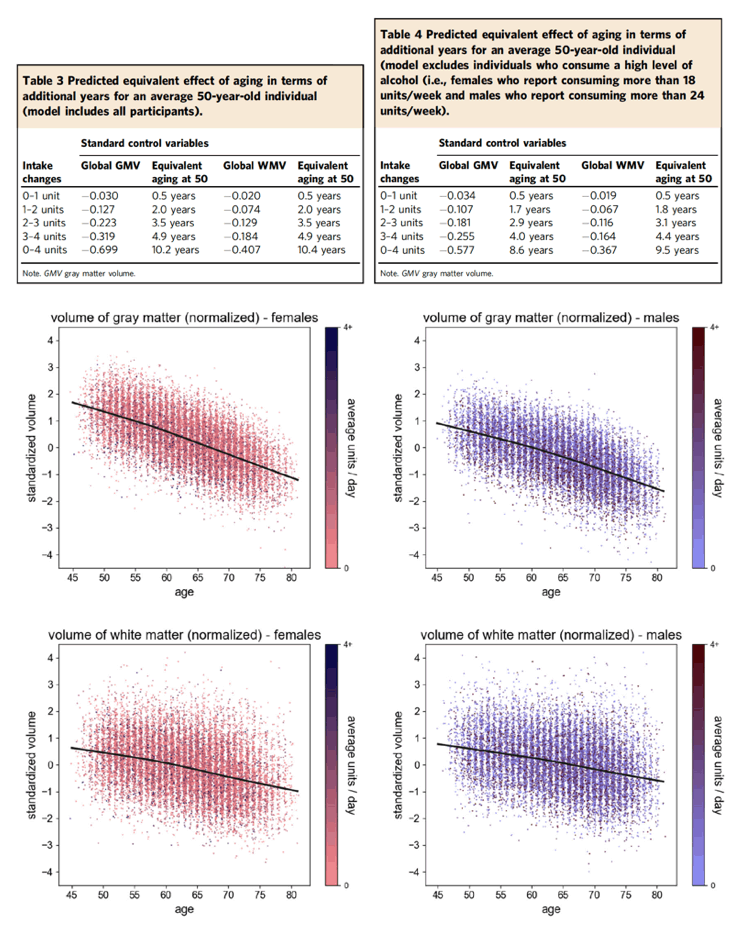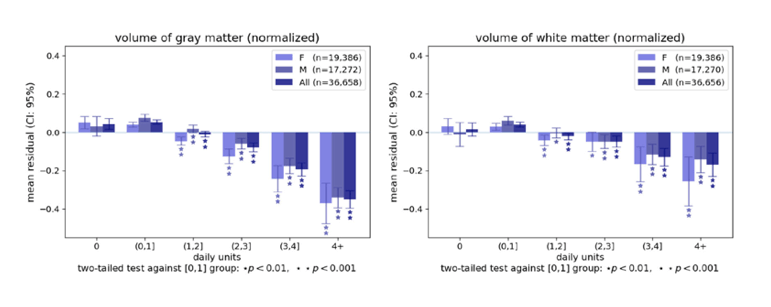| |
More alcohol, less brain: Association begins
with an average of just one drink a day
|
| |
| |
https://www.sciencedaily.com/releases/2022/03/220304090349.htm
Evaluation of Computerized Cognitive Training and Cognitive and Daily Function in Patients Living With HIV - PDF
March 4, 2022
Source:
University of Pennsylvania

Even light-to-moderate drinking is associated with harm to the brain, according to a new study. Researchers analyzed data from more than 36,000 adults that found a link between drinking and reduced brain volume that begins at an average consumption level of less than one alcohol unit a day -- the equivalent of about half a beer -- and rises with each additional drink.
The research, using a dataset of more than 36,000 adults, revealed that going from one to two drinks a day was linked with changes in the brain equivalent to aging two years. Heavier drinking was associated with an even greater toll. The science on heavy drinking and the brain is clear: The two don't have a healthy relationship. People who drink heavily have alterations in brain structure and size that are associated with cognitive impairments.
But according to a new study, alcohol consumption even at levels most would consider modest -- a few beers or glasses of wine a week -- may also carry risks to the brain. An analysis of data from more than 36,000 adults, led by a team from the University of Pennsylvania, found that light-to-moderate alcohol consumption was associated with reductions in overall brain volume.
The link grew stronger the greater the level of alcohol consumption, the researchers showed. As an example, in 50-year-olds, as average drinking among individuals increases from one alcohol unit (about half a beer) a day to two units (a pint of beer or a glass of wine) there are associated changes in the brain equivalent to aging two years. Going from two to three alcohol units at the same age was like aging three and a half years. The team reported their findings in the journal Nature Communications.
"The fact that we have such a large sample size allows us to find subtle patterns, even between drinking the equivalent of half a beer and one beer a day," says Gideon Nave, a corresponding author on the study and faculty member at Penn's Wharton School. He collaborated with former postdoc and co-corresponding author Remi Daviet, now at the University of Wisconsin-Madison, and Perelman School of Medicine colleagues Reagan Wetherill -- also a corresponding author on the study -- and Henry Kranzler, as well as other researchers.
"These findings contrast with scientific and governmental guidelines on safe drinking limits," says Kranzler, who directs the Penn Center for Studies of Addiction. "For example, although the National Institute on Alcohol Abuse and Alcoholism recommends that women consume an average of no more than one drink per day, recommended limits for men are twice that, an amount that exceeds the consumption level associated in the study with decreased brain volume,"
Ample research has examined the link between drinking and brain health, with ambiguous results. While strong evidence exists that heavy drinking causes changes in brain structure, including strong reductions in gray and white matter across the brain, other studies have suggested that moderate levels of alcohol consumption may not have an impact, or even that light drinking could benefit the brain in older adults.
These earlier investigations, however, lacked the power of large datasets. Probing massive quantities of data for patterns is the specialty of Nave, Daviet, and colleagues, who have conducted previous studies using the UK Biobank, a dataset with genetic and medical information from half a million British middle-aged and older adults. They employed biomedical data from this resource in the current study, specifically looking at brain MRIs from more than 36,000 adults in the Biobank, which can be used to calculate white and gray matter volume in different regions of the brain.
"Having this dataset is like having a microscope or a telescope with a more powerful lens," Nave says. "You get a better resolution and start seeing patterns and associations you couldn't before."
To gain an understanding of possible connections between drinking and the brain, it was critical to control for confounding variables that could cloud the relationship. The team controlled for age, height, handedness, sex, smoking status, socioeconomic status, genetic ancestry, and county of residence. They also corrected the brain-volume data for overall head size.
The volunteer participants in the Biobank had responded to survey questions about their alcohol consumption levels, from complete abstention to an average of four or more alcohol units a day. When the researchers grouped the participants by average-consumption levels, a small but apparent pattern emerged: The gray and white matter volume that might otherwise be predicted by the individual's other characteristics was reduced.
Going from zero to one alcohol units didn't make much of a difference in brain volume, but going from one to two or two to three units a day was associated with reductions in both gray and white matter.
"It's not linear," says Daviet. "It gets worse the more you drink."
Even removing the heavy drinkers from the analyses, the associations remained. The lower brain volume was not localized to any one brain region, the scientists found.
To give a sense of the impact, the researchers compared the reductions in brain size linked with drinking to those that occur with aging. Based on their modeling, each additional alcohol unit consumed per day was reflected in a greater aging effect in the brain. While going from zero to a daily average of one alcohol unit was associated with the equivalent of a half a year of aging, the difference between zero and four drinks was more than 10 years of aging.
In future work, the authors hope to tap the UK Biobank and other large datasets to help answer additional questions related to alcohol use. "This study looked at average consumption, but we're curious whether drinking one beer a day is better than drinking none during the week and then seven on the weekend," Nave says. "There's some evidence that binge drinking is worse for the brain, but we haven't looked closely at that yet."
They'd also like to be able to more definitively pin down causation rather than correlation, which may be possible with new longitudinal biomedical datasets that are following young people as they age.
"We may be able to look at these effects over time and, along with genetics, tease apart causal relationships," Nave says.
And while the researchers underscore that their study looked only at correlations, they say the findings may prompt drinkers to reconsider how much they imbibe.
"There is some evidence that the effect of drinking on the brain is exponential," says Daviet. "So, one additional drink in a day could have more of an impact than any of the previous drinks that day. That means that cutting back on that final drink of the night might have a big effect in terms of brain aging."
In other words, Nave says, "the people who can benefit the most from drinking less are the people who are already drinking the most."
-------------------------------

March 4 2022
Abstract
Heavy alcohol consumption has been associated with brain atrophy, neuronal loss, and poorer white matter fiber integrity. However, there is conflicting evidence on whether light-to-moderate alcohol consumption shows similar negative associations with brain structure. To address this, we examine the associations between alcohol intake and brain structure using multimodal imaging data from 36,678 generally healthy middle-aged and older adults from the UK Biobank, controlling for numerous potential confounds. Consistent with prior literature, we find negative associations between alcohol intake and brain macrostructure and microstructure. Specifically, alcohol intake is negatively associated with global brain volume measures, regional gray matter volumes, and white matter microstructure. Here, we show that the negative associations between alcohol intake and brain macrostructure and microstructure are already apparent in individuals consuming an average of only one to two daily alcohol units, and become stronger as alcohol intake increases.
We further used our regression models to calculate the predicted change in global GMV and WMV associated with increasing daily alcohol intake by one unit (Table 2). This prediction is similar when using different sets of control variables and when excluding individuals who did not consume alcohol or those who consume a high level of alcohol (for illustration, the change resulting from increasing alcohol intake from zero to one daily unit results in a reduction of -0.030 SD in global GMV and -0.020 SD in global WMV in the model estimated on the full sample and the model that excludes individuals who consume a high level of alcohol yields negative associations of similar magnitudes: -0.034 SD in global GMV and -0.019 SD in WMV. Given the non-linear relationship between global IDPs and alcohol intake, the associations vary across the drinking range. The change in the predicted global GMV and WMV when shifting from no daily alcohol consumption to one daily alcohol unit was less than 0.03 standard deviations. However, the observed associations between alcohol intake and global IDPs increase as the number of daily units increases. An increase from one to two daily units is associated with a decrease of 0.127 and 0.074 standard deviations in predicted global GMV and WMV, respectively. A change from two to three daily units is associated with a 75% greater decrease of 0.223 and 1.28 standard deviations in GMV and WMV, respectively. Table 3 benchmarks the predicted effect magnitudes against the effects associated with aging for an average 50-year-old UKB participant, based on our regression models in the full sample. Table 4 replicates these results using the models that exclude individuals who consume a high level of alcohol. For illustration, the effect associated with a change from one to two daily alcohol units is equivalent to the effect of aging 2 years (or 1.7 years in the model that excludes individuals who consume a high level of alcohol), where the increase from two to three daily units is equivalent to aging 3.5 years (or 2.9 years in the model that excludes individuals who consume a high level of alcohol).


|
|
| |
| |
|
|
|